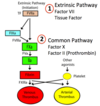Clotting Flashcards
(65 cards)
Hemostasis is:
- the arrest of bleeding from an injured blood vessel
Steps of Hemostasis:
- Arteriolar vasoconstriction
- Primary hemostasis
- Secondary hemostasis
- Regulation of thrombus formation
- Antithrombotic actvity
Arteriolar (local) vasoconstriction is due to:
- release of endothelin from endothelium cells lining blood vessels
Primary hemostasis is:
- formation of the platelet plug
Normal platelet count:
150K - 350K
Thrombocytopenia:
too few platelets
Thrombocytosis:
too many platelets
Does platelet size matter?
- Yes
- larger platelets are more prothrombotic (likely to stick)
The normal endothelial monolayer is anti-thrombogenic.
What happens when the endothelial monolayer is injured?
- Platelets in the bloodstream recognize collagen and von Willebrand factor (vWF) in the basement membrane and adhere to it.
Steps in formation of the platelet plug (primary hemostasis):
- adherence
- activation
- granule release
- shape change
- aggregation
von Willebrand factor is:
- a large circulating protein (multimer) that plays an important role in both primary and secondary hemostasis.
von Willebrand factor is produced by:
endothelial cells and megakaryocytes
Role of von Willebrand factor at a site of blood vessel injury (2):
- adheres to exposed collagen
- facilitates platelet tethering to sub-endothelial basement membrane
Steps in how von Willebrand factor (vWF) functions:
- vWF circulates in the blood in a closed conformation.
- At the site of injury, vWF binds to exposed collagen.
- vWF elongates into an open conformation revealing platelet binding sites.
- Platelets bind to vWF, become active, and aggregate onto elongated vWF.

What happens to platelets when they bind to elongated vWF and become activated?
- they release granules containing:
- adhesive proteins
- prothrombotic factors
- cytokines
- growth factors
- platelet agonists
The five components contained in platelet granules and that are released upon platelet activation:
- adhesive proteins
- prothrombotic factors
- cytokines
- growth factors
- platelet agonists
Low platelet counts result in:
- petechiae
- reddish purple discolorations on the skin that do not blanche on applying pressure.
Petechiae are:
- reddish purple discolorations on the skin that do not blanche on applying pressure.
- 1-3mm in size.
- result from low platelet counts.
Secondary hemostasis is:
- the process by which cross-linked fibrin is formed.
Why is secondary hemostasis necessary?
- initial platelet plug is not very strong and requires a “sealant”
- “sealant” = cross-linked fibrin
Most coagulation factors are:
- serine proteases that circulate as zymogens in the blood stream plasma
Nomenclature: what is the name of Factor 10 when in its active form?
- Factor 10a
- “a” is added to the end of active factors
The three pathways of secondary hemostasis:
- extrinsic pathway
- intrinsic pathway
- common pathway
What is Tissue Factor?
- a transmembrane protein synthesized and expressed by endothelial cells and monocytes.
- triggers first step in extrinsic pathway coagulation.
NOT NORMALLY EXPRESSED - ONLY IN INJURY






